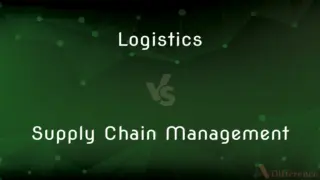Reaction Quotient vs. Equilibrium Constant — What's the Difference?
By Tayyaba Rehman — Published on December 3, 2023
Reaction Quotient (Q) calculates the ratio of products to reactants at any point in time, while Equilibrium Constant (K) gives this ratio when the reaction is at equilibrium.

Difference Between Reaction Quotient and Equilibrium Constant
Table of Contents
ADVERTISEMENT
Key Differences
Reaction Quotient (Q) and Equilibrium Constant (K) are both measures that describe the state of a chemical reaction. While they might appear to serve a similar purpose, they are distinct in their implications. The Reaction Quotient provides insight into the direction in which a reaction might proceed, by comparing the concentration of products and reactants at any given moment. On the other hand, the Equilibrium Constant represents a special case of Q, where the reaction has reached a state of equilibrium, meaning the rate of the forward and backward reactions are equal.
Reaction Quotient (Q) is calculated using the same formula as the Equilibrium Constant, but it does so using current concentrations, not those at equilibrium. Essentially, it's a snapshot of the reaction at a specific time. Depending on its value relative to the Equilibrium Constant, one can determine the direction in which the reaction is likely to shift. If Q < K, the reaction will tend to move in the forward direction, producing more products. Conversely, if Q > K, the reaction will shift backward, forming more reactants.
Equilibrium Constant (K), unlike the Reaction Quotient, remains constant for a given reaction at a given temperature, regardless of the initial amounts of reactants or products. It represents the balance point of a reaction. If you know the Equilibrium Constant, you can predict the concentrations of reactants and products once equilibrium is reached.
In summary, while both Reaction Quotient and Equilibrium Constant are based on the same mathematical formula, the former provides a momentary snapshot of a reaction, whereas the latter represents a constant value, indicative of the equilibrium state of a reaction.
Comparison Chart
Definition
Ratio of products to reactants at any time.
Ratio at equilibrium.
ADVERTISEMENT
Changes with time?
Yes, as concentrations change.
No, constant for a given temperature.
Indicates
Direction of reaction shift.
Balance point of reaction.
Affected by Initial Amounts?
Yes, based on current concentrations.
No, only by temperature.
Use
To determine reaction's position relative to equilibrium.
Predict concentrations at equilibrium.
Compare with Definitions
Reaction Quotient
Reaction Quotient aids in understanding whether a system is at equilibrium.
If Q = K, the system is at equilibrium and concentrations will not change.
Equilibrium Constant
Equilibrium Constant is solely temperature-dependent for a given reaction.
For an endothermic reaction, increasing the temperature often increases the value of K.
Reaction Quotient
Reaction Quotient is dynamic and changes until equilibrium is reached.
As the reaction progresses, Q approaches the value of K.
Equilibrium Constant
The Equilibrium Constant (K) signifies the ratio of products to reactants at the equilibrium state of a reaction.
For a reaction in equilibrium, the ratio of product to reactant concentrations is always K.
Reaction Quotient
The Reaction Quotient (Q) measures the relative amounts of products and reactants present during a reaction at any point in time.
For the reaction not at equilibrium, Q does not equal K.
Equilibrium Constant
It provides a reference point to predict the direction of reaction shift.
Knowing K helps to predict whether a reaction will shift to the right or left.
Reaction Quotient
Q can be used to predict the direction a reaction will proceed.
If Q < K, the reaction will produce more products.
Equilibrium Constant
It indicates the extent to which reactants are converted to products at equilibrium.
A large K indicates that products are favored at equilibrium.
Reaction Quotient
It is calculated using the concentrations or partial pressures of the products and reactants.
For a gaseous,-clicker the value of Q can be found using partial pressures in gas phase reactions.
Equilibrium Constant
K remains constant at a given temperature for a specific reaction.
Increasing the concentration of a reactant does not change K, only Q.
Common Curiosities
Can the value of Reaction Quotient change?
Yes, Q changes as the reaction progresses and concentrations change.
What does it mean if Q is greater than K?
It means the reaction will shift towards the reactants to reach equilibrium.
What is the Reaction Quotient?
The Reaction Quotient (Q) calculates the ratio of products to reactants at any point in time during a reaction.
How is the Equilibrium Constant (K) different from Q?
K gives the ratio of products to reactants when the reaction is at equilibrium, whereas Q can be for any point in time.
Does the Reaction Quotient have units?
No, Q is a ratio and therefore is dimensionless.
How is the value of K determined?
K is determined experimentally when the reaction reaches equilibrium.
How does temperature affect the Equilibrium Constant?
K is temperature-dependent and can change with temperature shifts.
How are the expressions for Reaction Quotient and Equilibrium Constant derived?
Both are derived based on the stoichiometry of the reaction using concentrations or partial pressures.
Can the Reaction Quotient be used to find K?
No, Q can indicate the direction of the reaction shift, but K is determined separately.
What happens if Q equals K?
The reaction is at equilibrium, and there will be no net change in concentrations.
Does the Equilibrium Constant change with concentration?
No, K is constant for a given reaction at a specific temperature, irrespective of concentration.
Can Q provide information about reaction kinetics?
No, Q provides thermodynamic information, not kinetic.
Is K always a constant for a particular reaction?
While K is constant at a specific temperature, it can change if the temperature changes.
Why is the Equilibrium Constant significant?
K provides insight into the extent of a reaction and the concentrations of reactants and products at equilibrium.
Is it possible for K to have a value of zero?
No, K cannot be zero. A very low K means reactants are favored.
Share Your Discovery

Previous Comparison
Logistics vs. Supply Chain Management
Next Comparison
Hire Purchasing vs. LeasingAuthor Spotlight
Written by
Tayyaba RehmanTayyaba Rehman is a distinguished writer, currently serving as a primary contributor to askdifference.com. As a researcher in semantics and etymology, Tayyaba's passion for the complexity of languages and their distinctions has found a perfect home on the platform. Tayyaba delves into the intricacies of language, distinguishing between commonly confused words and phrases, thereby providing clarity for readers worldwide.












































